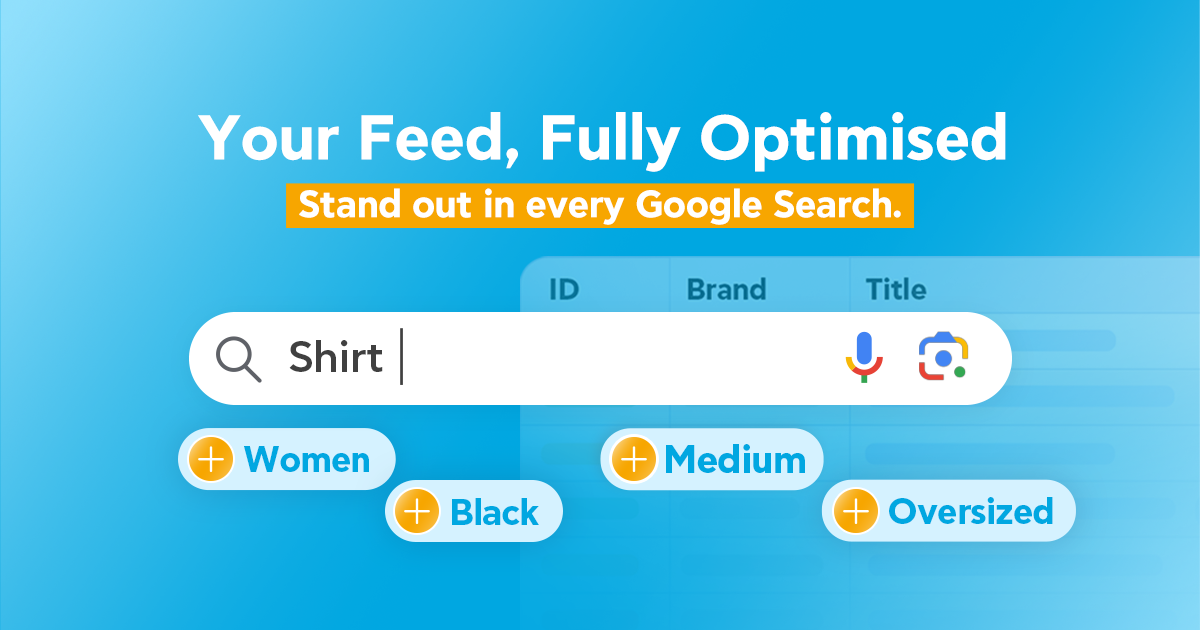In Google feed optimization, the accuracy and completeness of your product data are non-negotiable. Every attribute in your Google Merchant Center feed must match your site exactly. Even small mismatches, such as a price difference or outdated availability, can lead to disapprovals, stopping ads, removing free listings, or even causing account restrictions.
Your feed is the foundation of your visibility and competitiveness in Google Shopping. This is not a full checklist of all required attributes. Instead, it’s a focused analysis of the product data fields that have the greatest direct impact on performance in Google Shopping, both in paid ads and free listings. These attributes apply across all verticals, from fashion and technology to furniture and pharmacy, but the exact values should be tailored to your products.
Basic Product Data
- The id is your product’s unique identifier in the feed. Keep it consistent to preserve performance history.
- The title is your ad headline. Clearly state the brand, product type, and key attributes like size, color, or model. Use keywords shoppers search for, but avoid irrelevant terms or promotional phrases, such as “Free Shipping” or “Sale.”
- The description expands on the title, providing a concise, benefit-driven overview with relevant keywords used naturally.
- The link should go directly to the product landing page on your verified domain, displaying the same details as in the feed to prevent disapprovals.
- The image_link is your main visual. Use high-resolution images with the product clearly shown on a neutral background. Avoid watermarks, promotional text, or brand-only images.
Price & Availability
- The price must be accurate, use ISO 4217 currency codes, and update in real time.
- If running promotions, sale_price displays the discounted amount, while sale_price_effective_date ensures Google switches between prices automatically.
- The availability attribute signals whether a product is “in stock,” “out of stock,” or “preorder.” Keep it current to avoid wasted clicks and lost trust.
Product Category
- The google_product_category must be the most accurate choice from Google’s taxonomy to appear in the right searches.
- The product_type is your own categorization. It doesn’t affect eligibility, but is valuable for structuring campaigns and analyzing performance.
Product Identifiers
The brand attribute is required for most new products.
- GTIN (Global Trade Item Number) is not required in all cases but can improve performance for standardized products like electronics or branded footwear. It enables Google to match your listing to its catalogue, unlocking competitive insights and richer ad formats.
- MPN (Manufacturer Part Number) is relevant in categories such as replacement parts or niche electronics when GTIN is not provided.
Accuracy is critical — if you cannot provide the correct GTIN or MPN, leave the field empty to avoid harming eligibility and ranking.
Detailed Product Description + Condition
- The color attribute improves matching for searches like “red sofa” or “black leather boots.”
- Gender is required for apparel and related accessories, with values “male,” “female,” or “unisex.”
- The size attribute increases ad relevance for searches including size terms. Only include sizes that are available to avoid disappointing buyers and wasting clicks.
- Material influences purchase decisions in multiple verticals, from apparel to furniture and jewellery.
- Condition specifies whether the product is “new,” “used,” or “refurbished.” This attribute is essential in categories like electronics, luxury goods, and resale fashion, where the state of the item greatly influences buyer expectations, pricing strategy, and ad performance. Providing the correct condition also ensures your product appears in relevant filters when shoppers narrow down their search results.
- The additional_image_link allows extra angles or detail shots, while lifestyle_image_link shows the product in real-life contexts, such as furniture in a styled room or jewellery on a model. These can increase engagement, especially in visual categories.
- For technical or complex products, product_detail provides structured specifications such as dimensions, weight, or compatibility.
Shipping Details
- The shipping attribute defines delivery cost, country, and service level. It can be set per product in the feed or globally in Google Merchant Center. Competitive, transparent shipping can improve click-through and conversion rates, particularly in price-sensitive verticals.

For Experts – Going the Extra Mile
Custom labels (custom_label_0 through custom_label_4) are optional but powerful for campaign management. Use them to tag products by seasonality, clearance status, margin, or other strategic categories. These labels are invisible to shoppers but useful for internal optimization and advanced segmentation.
Final Thoughts
Optimizing your Google Shopping feed means more than meeting minimum requirements. It’s about providing complete, accurate, and relevant data that aligns perfectly with your website, ensuring your products show up in the right searches. A well-structured feed will enhance both paid Shopping Ads and free listings, driving better results across all e-commerce verticals.
If you’re ready to take your Shopping Ads to the next level, contact Shoply today to learn how our advanced tools and expertise can help you succeed.
Get started with Shoply now! Visit Shoply to explore how our solutions can transform your Google Shopping Ads performance.



